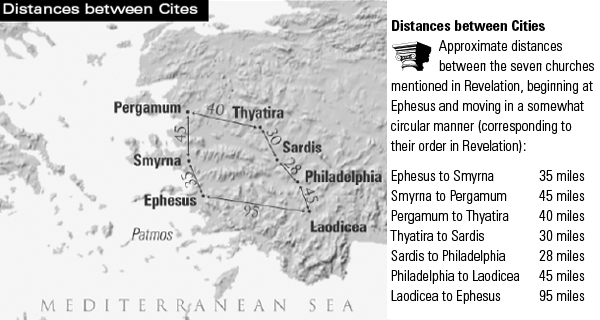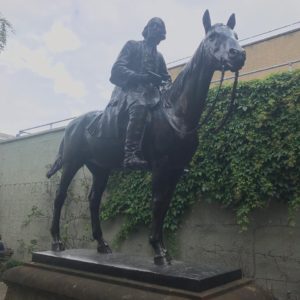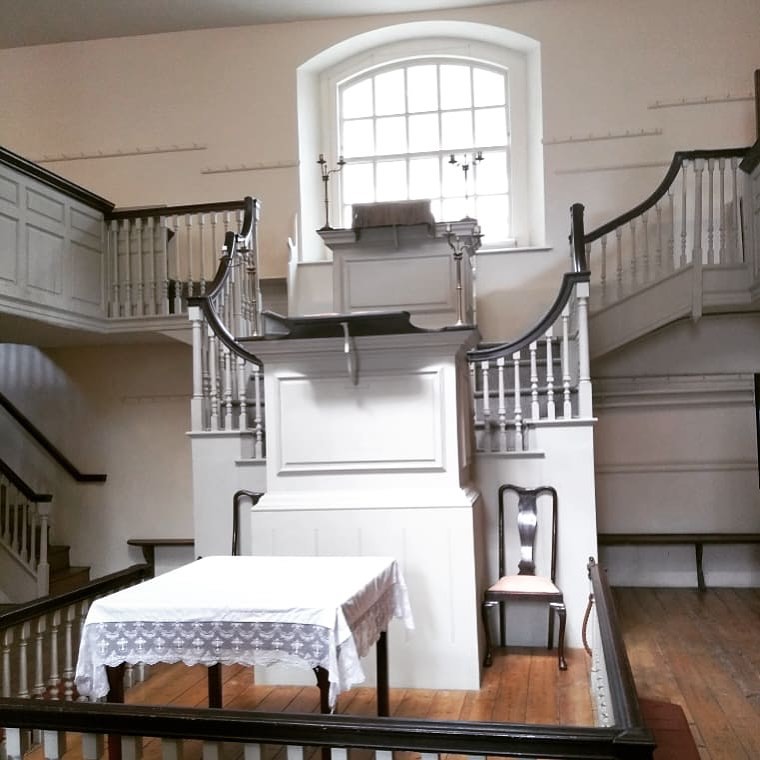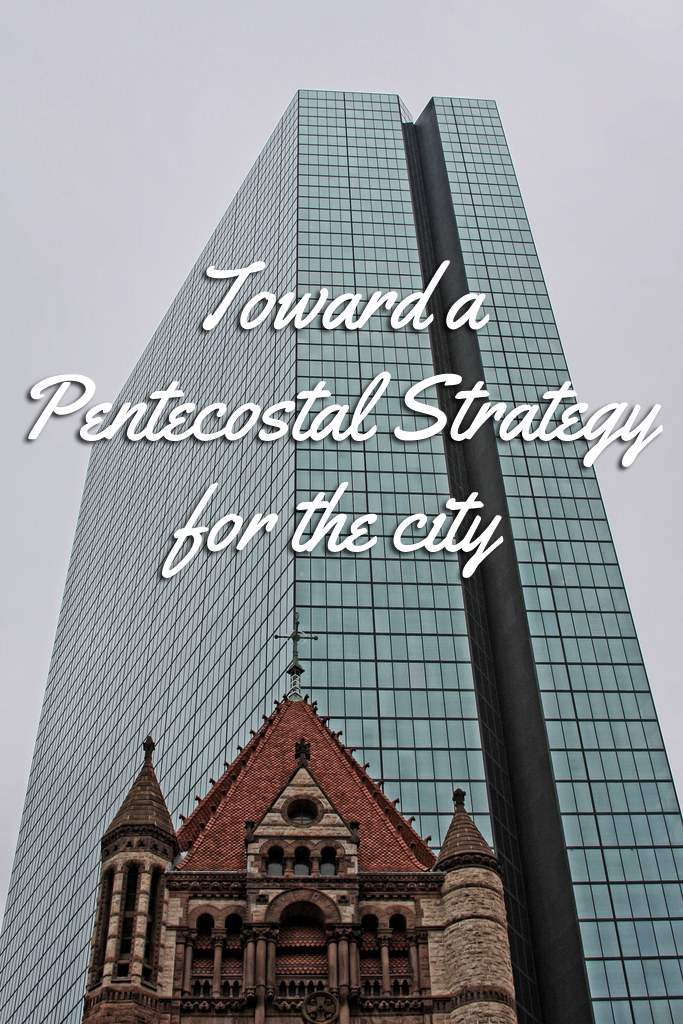Ministry by Walking Around and the Network of Seven Churches of Revelation
Ministry by Walking Around and the Network of Seven Churches of Revelation
Although the Book of Revelation has been vastly studied and interpreted throughout church history, usually the focus is on one major issue within the text, namely, the role and future of the church. The main reason for this has been the in-depth prophetic and pastoral messages to the Seven Churches.
The value of the messages to the Seven Churches of Revelation is constituted by the fact that they are the last recorded Biblical messages to the Christian Church.[1] The letters to the Seven Churches obviously do not contain all of the usual elements used in the New Testament epistolary form. It is generally accepted that they were written as an application of the Revelation context and not as individual messages to the churches.
This contextual connection between the seven letters suggests a network of inter-church communication which was established between the seven churches. Several common elements are obvious from the text, the most obvious is their common geographical location as shown in Figure 1.
Figure 1: Distances between the Seven Cities of Revelation
The addressed churches are located clockwise, almost like they are forming a strategic circle of ministry.[2] Most churches are located thirty to forty miles from one another, which perhaps was the possible daily limit for traveling during that time. The shape of the circle of ministry, based on the order in which the churches were addressed, suggests a method of managing known today as Management by Walking Around (MBWA). The example in Revelation not only presupposes such methodology, but purposefully gives its clockwise direction in relation to the location of origin of the letters from the Island of Pathmos.
The purposeful positioning of the churches provided a common network (circle of ministry). It is also obvious from the text that at the time of writing, simplicity and democracy in organization were characteristics of the New Testament church government.[3] In the context of networking, each church maintained its own individuality because it is addressed separately in the text.[4]
Furthermore, the seven churches shared a common context of ministry in the area of Asia Minor which consisted of a great mixture of languages, customs and religions. All of the seven churches were located in cities which were under Roman rule and combined the customs of Roman, Greek, Assyrian, Persian, Babylonian, Egyptian and Jewish cultures as well as the various languages and dialects within them. The commonality in the context of ministry continued with the presence of numerous religious groups, cults, sects and gilds which were closely interwoven with civil affairs. Universal citizenship, universal religion, and a universal church were all ideas for which the Roman Empire was beginning to prepare. In such context, the seven churches shared a common goal of ministry, namely, spreading the Christian message.[5]
The seven letters were inspired by one occasion and one purpose as a tool for inter-church networking.[6] The message was not sporadic or spontaneous but thoughtfully planned and designed for each of the churches, based on an in-depth knowledge of the individual problems, members and solutions for future development.[7] The text demonstrates a common structure within the church illustrated by the common structure shared by each message. The letters reveal that the congregations shared similar practices of worship, ministry and teaching which were accompanied by problems and persecution.
A significant part of the common structure was the leadership because each church had a divinely-appointed messenger,[8] addressed by a common “divinely-charged”[9] network elder, who received a transmitted divine message. Such process shows that the networking was done by means of communication, of which the epistolary form is also proof.[10] The written text was only a formal documentary or a contract of the holistic communication accomplished through various multimedia means including those that relied on audio, visual and other senses. It constructed a mystical, divinely-inspired, supernatural and non-virtual reality which transformed the recipient of the message in the same way it did the messenger. Through this means, the network communication was not a miscommunication, but rather an authentic translation from the divine source to the very members of the congregations.
This form of communication was absolutely necessary for the common context of ministry in which the seven churches operated. This common context was the earth, not heaven,[11] and their common goal was to conquer.[12] Yet, at the same time the text is undisputable in that each church contained people prepared to conquer. This fact makes the victory of the church inevitable. Thus, while the churches are dealing with various problems and persecutions, they are already conquerors.
This observation brings the reader to the final commonality which the seven churches share; namely, that besides the earthly network of ministry there is another greater, divine, heavenly network which is in control. Such a conclusion is obvious from the fact that all of the churches without exception are known to the sender of the messages.[13] Their problems are relevant, criticism and encouragement which are prophetically delivered solutions are divinely provided and conquest of the church over the problems is definite and inevitable. This is undisputable proof that a God-centered New Testament networking of churches is the dependable and enduring model for both ministry networking and church government. Precisely this heavenly network is the supernatural source of the unique approach through which problems of the churches are to be solved. Thus, in addition to a common present reality, the churches share a future earthly applicability of the paradigm of ministry which makes their message relevant today.[14]
[1] Wade H. Horton, Lectures on the Seven Churches (Cleveland: Pentecostal Resource Center, n/a), 6.
[2] Henry M. Morris, The Revelation Recorded (Wheaton: Tyndale House Publishers, 1987), 66. Merril Tenney, Interpreting Revelation (Grand Rapids: Wm. B. Eerdmans Pubslihing Co., 1957), 50. For an in-depth discussion on the geographical location of the Seven Churches, its significance for the circulation of the letters and the leadership organization see William M. Ramsey, The Letters to the Seven Churches (Grand Rapids: Baker book House, 1979), 186.
[3] McDowell, 38.
[4] McDowell, 37.
[5] Ramsey, 120-21.
[6] Ramsey, 40.
[7] Ramsey, 39-40.
[8] Bruce M. Metzger, Breaking the Code (Nashville: Abingdon Press, 1993), 30. Ramsey, 69, 74ff.
[9] Ramsey, 80.
[10] McDowell, 37.
[11] Metzger, 29.
[12] Metzger, 30.
[13] Wade Horton, Seven Golden Candlesticks (Cleveland: Pathway Press, 1974), 72.
[14] Edward A. McDowell, The Meaning and Message of the Book of Revelation (Nashville: Broadman Press, 1951), 35. Clovis G. Chappell, Sermons from Revelation (New York: Abingdon-Cokesbury Press, n/a), 59.
40 False Beliefs of the Church Today
1. That Christianity is a religion and social status, rather than a personal life of holiness and relationship with God.
2. That Christians need standards and rules other than the Bible in order to live a Christian life.
3. That the divinely inspired text of the Bible needs human additions and alterations.
4. That the practices described by the Bible are not for today, as if the Bible is wrong.
5. That Christianity is religion for the weak.
6. That governments and countries are responsible for the growth and prosperity of the church.
7. That we must accept the world in order that the world accepts us.
8. That Postmodernity is Biblical teaching.
9. That the evolution theory is compatible with the Biblical teaching of the Creation.
10. That God needs our strategies, offices, plans and training based on the principles of the contemporary marketing and management in order to lead His Church like His strength has vanished.
11. That the church is successful only because of our personal participation.
12. That the personal works of righteousness are more important than the works of faith which the Word requires from us.
13. That life without sin is not possible.
14. That man has no free will, but is a subject of predetermined choice.
15. That once saved, a person is always saved regardless of the lifetime between his/her salvation and death.
16. That the Trinity is a composite of three different persons, and is not trinitarian nor monotheistic.
17. That Jesus Christ becomes the Son of God only after the incarnation.
18. That the leadership of the Holy Spirit is not needed in the church any longer.
19. That there is baptism of the Holy Spirit without speaking in other tongues.
20. That the gifts of the Holy Spirit can be practiced without a life of holiness.
21. That there is Biblical preaching without confirmation from the Holy Spirit with gifts and miracles.
22. That only elected men can preach the Gospel, as if the preaching of the Gospel is not an obligation of every believer.
23. That the Revival in the church is for a particular period of time and not a personal responsibility for every believer to live a life of revival.
24. That only because the Church does not operate under the anointing given to it, the gifts of the Holy Spirit have ceased to exist.
25. That only because we do not have personal discipline to pray and fast until God answers our prayers, He cannot do miracles as He has done before.
26. That because some prosperity teachings have over exaggerated some doctrines God does not supply needs any longer.
27. That one can change the spiritual laws and reap without having sowed.
28. That it is more blessed to receive than to give.
29. That to show mercy is an act of weakness.
30. That the minorities in the church, which form its ethnic variety, are its worst part.
31. That you can be a part of the Church without being part of the Spiritual Warfare.
32. That you can be victorious without Christ, without his sacrifice on the cross and without the power of his blood.
33. That when you are personally upset with certain people you have the right to simply leave the church.
34. That not going to church as an act of protest is an acceptable form of Christian behavior.
35. That cell groups without leadership and accountability are the apostolic model for the church.
36. That there are two kinds of Christians – layman and clergy, and that the Church must be without structure and hierarchy.
37. That there is no Rapture of the Church.
38. That the Rapture and the Second Coming are the same event.
39. That the Rapture is not before the Tribulation.
40. That the unrighteous and the ones who evidently live a life of sin will participate in the rapture of the Church and will be resurrected with the righteous dead.
Set yourself on fire…
New Wesley Room at Bristol
Here is a bit more about the building from the Methodist Heritage Organization:
George Whitefield invited John Wesley to preach outdoors for the first time to the miners of Bristol in 1739. Within a few weeks’ work started on building the New Room as a meeting place for two of the religious societies in the city, thus creating the world’s first Methodist building.
The current building dates from 1748 when the New Room was doubled in size. Its lower floor became known as John Wesley’s Chapel. It is still in regular use for worship as well as being used for cultural and educational activities and exhibitions. Upstairs John Wesley created twelve rooms around a beautiful central octagonal window. These provided accommodation for himself and any visiting preachers assigned to the Bristol circuit. They now contain a highly interactive Museum devoted to telling the story of John and Charles Wesley and the relevance of their work today.
Being well placed in the heart of the city, the New Room became a center for the Wesleys’ work in Bristol. It was where John’s strong sense of social justice was first expressed. The New Room became a base for running a school for the poor, for providing food and clothes to the needy, for offering free medical care to the sick, and for helping those in the nearby prison. It was also the first place to use John Wesley’s ‘class’ system, where members were divided into sub-groups for mutual support and development. The New Room has been described as ‘the cradle of Methodism’.
The New Room was one of John Wesley’s three key centers. Many of the annual conferences were held there, including the one that first created Methodist circuits. Bristol’s trading links encouraged the growth of American Methodism. Thomas Webb, Francis Asbury, and others committed themselves to working there and sailed from nearby.
Encouraged by the Diary of JOHN WESLEY
O HOLY GOD we, have come to a point where
pastors text and post on facebook during sermon hour while thousands are going to hell in a hand basket while listening to a sermon
teachers be sipping a beer with friends on Saturday night and get up to teach Sunday school on Sunday morning still with alcohol on their breath
seminary professors teaching it is OK to drink in the Bible during the so called Theology on Tap meetings in a local pub
lonely pastors sitting in their cars shooting whiskey in the darkness of the church parking lot after preaching 2-3 services on Sunday
preachers are concerned with every social, political and cultural issues except the salvation of eternal human souls
We read the story in Wesley’s journal:
Sunday, 7.-–I preached again at St. Lawrence’s in the morning, and afterward at St. Katherine Cree’s Church. I was enabled to speak strong words at both; and was therefore the less surprised at being informed that I was not to preach any more in either of those churches.
The following weekend – Sunday, 14.–I preached in the morning at St. Ann’s, Aldersgate; and in the afternoon at the Savoy Chapel on free salvation by faith in the blood of Christ.
I was quickly apprised that at St. Ann’s, likewise, I am to preach no more.
I preached at St. John’s, Wapping at 3PM and at St. Bennett’s, Paul’s Wharf, in the evening.
At these churches, likewise, I am to preach no more
THEN HE WRITES:
Monday, Tuesday, and Wednesday, I had continual sorrow and heaviness in my heart.
BUT THEN Wednesday, May 24.– about five this morning that I opened my Testament on those words
“There are given unto us exceeding great and precious promises, even that ye should be partakers of the divine nature” [II Peter 1:4].
Just as I went out, I opened it again on
those words, “Thou art not far from the kingdom of God” [Mark 12:34].
In the afternoon I was asked to go to St. Paul’s. The anthem was, “Out
of the deep have I called unto Thee, O Lord: Lord, hear my voice. Oh,
let Thine ears consider well the voice of my complaint
“I Felt My Heart Strangely Warmed”
In the evening I went very unwillingly to a society in Aldersgate Street where one was reading Luther’s preface to the Epistle to the Romans. About a quarter before nine, while he was describing the change
which God works in the heart through faith in Christ, I felt my heart strangely warmed.
I felt I did trust in Christ, Christ alone, for salvation; and an assurance was given me that He had taken away my sins, even mine, and saved me from the law of sin and death.
I began to pray with all my might for those who had in a more especial
manner despitefully used me and persecuted me.
I then testified openly to all there what I now first felt in my heart
Banned from most churches in the area, he meets with Whitfield who has just returned from America
Whitfield tells him they can minister in the fields like they did in America
Thursday, 29th –-I left London as I could scarcely reconcile myself at first to this strange way of preaching in the fields, of which Whitfield set me an example on Sunday;
I had been all my life (till very lately) so tenacious of every point relating to decency and order
that I should have thought the saving of souls almost a sin if it had not been done in a church.
Monday, 2.--At four in the afternoon, I submitted to be more vile and proclaimed in the highways the glad tidings of salvation, speaking from a little eminence in a ground adjoining to the city where gathered 3,000 people
Sunday, 8.--At seven in the morning I preached to about a thousand persons at Bristol, and afterward to about fifteen hundred on the top of the Mount in Kingswood.
Tuesday, 17.–At 5 in the afternoon I was at a little society in the Back Lane. The room in which we were was propped beneath, but the weight of people made the floor give way; so in the very beginning of PREACHING the post which propped it fell down with a great noise.
NEVERTHELESS the floor sank no farther; so that, after a little surprise at first, they quietly attended to the words that were spoken.”
First Day of School in Bulgaria
Bulgarian Churches Protest against new Child Protection Policy
Several of our students who graduated from our chaplaincy program in Bulgaria about a decade ago, are among the lead organizers of a massive international wave of protests against a new package of child protection laws similar to Norway’s Barnevernet concept. The start is given in Sofia, Capital city of Bulgaria, where people are very unhappy about a new ideological concept of child protection policy which infringes upon the rights of the parents and the integrity of natural family. The protest will be organized through the whole month of September 2019 in many cities of Bulgaria and in other cities throughout the world with many parents turned into grassroots pro-family activists.
The new legal provisions in Bulgaria
Thus, according to the new laws, Bulgarian activists say that:
- multidisciplinary teams (police, social workers, psychologists) will be able to enter people’s homes without a court order and remove children even based on anonymous calls saying the child is neglected or abused
- then the child is placed into foster care via administrative procedure until brought to court, which can take months and in some cases years
- from then onwards, under certain conditions of the law and through non-governmental organizations, the removed child can be adopted by people from all over the world
- after international adoption, the biological family will never see that child again (personal data such as personal ID number, certificate of birth will be changed).
Our information is that Romanian law also includes some similar provisions, but there is still little institutional capacity to implement them. NGOs are already involved in social services and even adoptions in Romania, only that this is little known to the public.
The new concept and ideology was heavily promoted in Bulgaria through Norwegian grants and that is why in some cities the protests will be held in the front of Norway’s embassies and consulates.
„We are worried that Norways has heavily invested in Bulgaria. Our politicians are ready to sell our country’s children. We are a small country, we shall never be England or Germany, so we shall never have their standards of living. And yet they are already removing Bulgarian children from their families based on the reason of poverty. And the Social Services Law adopted in March 2019 will be in force starting from January 1st, 2020”, state the organizers.
Protests are taking place in September in Bulgaria, Germany, Poland, Italy, Canada, Austria, Ireland, Serbia, New Zeeland, Denmark, Lithuania, USA and even Norway.
It all started with a Child Strategy
In 2018, in Bulgaria, 152 NGOs were non-transparently financed outside the country to propose “The National Strategy for the Child 2019-2030”, under the slogan “All rights for all children”. It was forwarded to policy makers and decisional factors.
The strategy was based on the following presuppositions:
- all parents are incompetent and incapable and are potential abusers for their children (mentally and physically)
- only the state and NGOs have the right to decide regarding children and children will appropriately develop and thrive only under their expert care.
The strategy has the following characteristics:
- comprehensiveness of object (it targets all children at conception, no matter whether they are in a need, abandoned or injured, “the strategy targets the three stages of childhood, as a period of the entire human life cycle” – pregnancy and early childhood; childhood; teenage years).
- conflicts with the Bulgarian Constitution (Article 47): the “raising and upbringing of children“ is the “right and obligation of their parents,“ and the state’s role in this process is to assist them, not replace them.
- adopts the child-centered model (from the third protocol of the UN Convention, which has NOT been ratified by Bulgaria) – authorizing the child, regardless of the age and maturity, to make decisions and receive social services and counseling without PARENTAL CONSENT.
- defines the child as a separate entity, with separate rights, which is contrary to Bulgarian law, ignoring terms such as: minor, juvenile, parent, guardian/custodian, etc.
After a national protest in 30 Bulgarian cities, on May 11, 2019, Bulgaria’s Prime Minister stated: “There will be no Strategy, I will order the Minister of Labor and Social Policy to reiterate in the morning, lunchtime and evening at the briefing that there is no Strategy for the Children”.
Despite his words, the ideas embedded in the supposedly annulled Strategy are being passed as laws and regulations, changes and amendments that are even contrary to the Bulgarian Supreme Law and also contradict AIN principles enshrined in the European Convention on Human Rights. The ideas in the spirit of the Strategy were pushed into changes in 28 laws (starting with the Child Protection Act) and a passing of a whole new law – the Social Services Act.
Working for the benefit of various non-governmental organizations that promote gender ideology and sexual education, the Law on Social Services was adopted in March 2019 effective January 1, 2020.
„With this law, we have the complete abdication of the state, which openly admits that it is incapable of fulfilling its purpose. The social functions of the state are transferred to private organizations, often international ones (and there is no clear requirement for them to be licensed in Bulgaria). Moreover, every child is their target, not just children in need… The law is working for the benefit of various non-governmental organizations promoting gender ideologies as well as early sexual education.”
Bulgarian activists have now reached over 175,000 concerned citizens, both Bulgarians and foreigners living in Bulgaria. There have been numerous information campaigns and protests in over 30 cities across the nation, which have, unfortunately, been widely ignored by the media and politicians alike.
The Strategy and the new approach to Social and Child Services are based on the Norwegian Model and heavily funded by Norway and its grant mechanism. In the name of “the rights of the child,” politicians, lawmakers and NGOs are busy working to undermine what Bulgarians hold dear: the traditional family and the role of the parents.
Toward a Pentecostal Strategy for the City
Toward a Pentecostal Strategy for the City
One of the questions that seems to come up in this course discussion is how to change the world around us with a more positive and effective approach toward using the Gospel of Salvation. In this particular module, the difficulty addressed is ethnocentricity. The particularity of our search then arrives at the more detailed question, how can we change the culture (respectively subcultures) of our church congregations? This is a drastic move from a closed circle toward an outreach community that many congregations are unable to accomplish. How do we then empower such congregations to be transformed into cultural reach-outs to a single ethnos or multiple ethnic groups?
Problem
The problem in the first quarter of the 21st century has been incongruity of our church strategy with the times we live in and the mindset they occupy. We’ve been preparing the church for the multicultural battle, all and while we should have been equipping the saints how to rebuild the walls since the battle has been lost.
We’ve been equipping leaders for the ministry while the church ship has been sinking only to end up with well trained captains of a sunken fleet. And in a doomed attempt to reconcile the reality of the ministry with their training, they have turned to wave walkers who briefly surface for breaths of fresh air during Sunday worship only to return to the deep blue walk of their daily ministry never finding their lost piece of eight.
For the battle was lost long ago before the present generation of ministers ever came to existence. They know not the battle. They’ve only seen the ruins that were left within the broken walls of the church. And they have been struggling to reconcile the incomputable of what church eldership has been teaching them to battle against with the Nehemiah calling for restoration, which God has placed upon them. For the answer has never been in building a New Jerusalem for a fresh start, but restoring the old Jerusalem and its former glory to a new state that reclaims our history and heritage.
Context
Recent analysis of migrant churches in the United States reveals that the predominant majority of them are located in cities which have a high influxation and concentration of immigrants. Such localities are called “gateway cities”. Immigrants typically enter the United States through one of these cities and settle there. These areas contain over half of the foreign-born population in the United States as follows:
- New York, NY – Foreign born population 18.7%
- Los Angeles, CA – Foreign born population 27.1%
- Houston, TX – Foreign born population 12.3%
- Washington, DC – Foreign born population 8.6%
- Miami, FL – Foreign born population 33.6%
- Chicago, IL – Foreign born population 11.1%
- San Francisco, CA – Foreign born population 20.0%
Strategy
Asking the right questions is important, but the answers cannot be generic for all ethnic groups or cultural settings. There is a strong need to be flexible and observe changes in culture, but not to change the message of the Gospel or compromise our witness. Several common things are noted in any cultural setting where our ministry is involved:
First and foremost, people of all cultures prefer to be personal with a purpose, rather than being project driven. No one longs to be part of someone else’s project. Yet, our very existence demands personal purpose, which could serve as a great cultural catalyst in a church ministry.
Secondly, cross cultural ministry is not done merely on relationships, but on being real in the relationships. The greatest halt of ministry work is when people realize the relationship with the church has not been a real one, but merely a part of a program or a paradigm.
Finally, our cross cultural model for ministry should not be just salvation oriented, but soul oriented. There is a great difference between writing down the number of saved every Sunday and actually caring for the eternal well-being of the saved souls. In fact, this is so fundamentally determinative that it should be the goal in mind of every new church plant.
REVIVAL MUST GO ON…
In 2020, we will be celebrating 30 years in ministry. Twenty of them alone were spent in America where we have held some 3,000 services across 25+ different states. In these three decades, I have seen genuine revival with the Glory of God moving in only twice.
The first time was in 1990, right after the fall of the Berlin Wall in Bulgaria, when our youth group of a dozen students grew up to 300 during the spring semester alone. One of those nights, 26 young people literally walked through the door of the small hall we were renting, gave their lives to the Lord and were baptized with the Holy Spirit – all of them on the spot in that one service. I can still remember them all speaking in tongues and none of us knowing what just hit us. As the visible glory of God descended upon us, we were not able to shut down the service till well after midnight. We got written up for breaking curfew, but our names were written in Heaven.
The second time was at the turn of the century when in the summer of 1999 the Lord opened doors to preach over 20 revivals. I started seminary in the fall and travelled back to South Carolina literally every weekend that first semester just to finish all scheduled preaching appointments. Some of the readers of this letter well remember that one or more of those meetings were in your church. And I have been praying for the same move of God since then.
Though we have had similar trends in our ministry in 2014 and then at the start of 2017, it was only this year again that I am seeing the signs of a great revival taking place just like in 1989 and 1999. More and more ministers we contact share the same feel for another great revival and after much prayer, fasting and anticipation I have become convinced that God is on the move in 2019.
For these reasons, we are approaching this season of Revival Harvest Campaign in 2019-2020 with great anticipation. We urge you to pray along with us and seek the will of the Lord – what is it that He wants us to do in this season of upcoming Revival? A move of God of such magnitude and rarity should not be taken lightly!


































